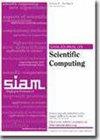用机器学习降低伽勒金粗网格算子的运算复杂度
IF 2.6
2区 数学
Q1 MATHEMATICS, APPLIED
引用次数: 0
摘要
SIAM 科学计算期刊》,提前印刷。 摘要我们提出了一种基于数据驱动和机器学习的方法,用于计算多网格(MG)方法中的非伽勒金粗网格算子,解决了众所周知的算子复杂性不断增加的问题。在关于光谱等效粗网格算子的 MG 理论指导下,我们开发了新颖的机器学习算法,利用神经网络与多网格特征值问题中的平滑测试向量相结合。所提出的方法有望降低粗网格算子的复杂性,同时保持解决参数偏微分方程问题的整体 MG 收敛性。对各向异性旋转拉普拉斯和线性弹性问题进行了数值实验,以展示该方法的性能,并与现有计算非 Galerkin 粗网格算子的方法进行比较。计算结果的可重复性。本文被授予 "SIAM 可重现徽章":代码和数据可用",以表彰作者遵循了 SISC 和科学计算界重视的可重现性原则。读者可通过 https://github.com/liruipeng/SparseCoarseOperator 获取代码和数据,以重现本文中的结果。本文章由计算机程序翻译,如有差异,请以英文原文为准。
Reducing Operator Complexity of Galerkin Coarse-grid Operators with Machine Learning
SIAM Journal on Scientific Computing, Ahead of Print.
Abstract. We propose a data-driven and machine-learning-based approach to compute non-Galerkin coarse-grid operators in multigrid (MG) methods, addressing the well-known issue of increasing operator complexity. Guided by the MG theory on spectrally equivalent coarse-grid operators, we have developed novel machine learning algorithms that utilize neural networks combined with smooth test vectors from multigrid eigenvalue problems. The proposed method demonstrates promise in reducing the complexity of coarse-grid operators while maintaining overall MG convergence for solving parametric partial differential equation problems. Numerical experiments on anisotropic rotated Laplacian and linear elasticity problems are provided to showcase the performance and comparison with existing methods for computing non-Galerkin coarse-grid operators. Reproducibility of computational results. This paper has been awarded the “SIAM Reproducibility Badge: Code and data available” as a recognition that the authors have followed reproducibility principles valued by SISC and the scientific computing community. Code and data that allow readers to reproduce the results in this paper are available at https://github.com/liruipeng/SparseCoarseOperator.
Abstract. We propose a data-driven and machine-learning-based approach to compute non-Galerkin coarse-grid operators in multigrid (MG) methods, addressing the well-known issue of increasing operator complexity. Guided by the MG theory on spectrally equivalent coarse-grid operators, we have developed novel machine learning algorithms that utilize neural networks combined with smooth test vectors from multigrid eigenvalue problems. The proposed method demonstrates promise in reducing the complexity of coarse-grid operators while maintaining overall MG convergence for solving parametric partial differential equation problems. Numerical experiments on anisotropic rotated Laplacian and linear elasticity problems are provided to showcase the performance and comparison with existing methods for computing non-Galerkin coarse-grid operators. Reproducibility of computational results. This paper has been awarded the “SIAM Reproducibility Badge: Code and data available” as a recognition that the authors have followed reproducibility principles valued by SISC and the scientific computing community. Code and data that allow readers to reproduce the results in this paper are available at https://github.com/liruipeng/SparseCoarseOperator.
求助全文
通过发布文献求助,成功后即可免费获取论文全文。
去求助
来源期刊
CiteScore
5.50
自引率
3.20%
发文量
209
审稿时长
1 months
期刊介绍:
The purpose of SIAM Journal on Scientific Computing (SISC) is to advance computational methods for solving scientific and engineering problems.
SISC papers are classified into three categories:
1. Methods and Algorithms for Scientific Computing: Papers in this category may include theoretical analysis, provided that the relevance to applications in science and engineering is demonstrated. They should contain meaningful computational results and theoretical results or strong heuristics supporting the performance of new algorithms.
2. Computational Methods in Science and Engineering: Papers in this section will typically describe novel methodologies for solving a specific problem in computational science or engineering. They should contain enough information about the application to orient other computational scientists but should omit details of interest mainly to the applications specialist.
3. Software and High-Performance Computing: Papers in this category should concern the novel design and development of computational methods and high-quality software, parallel algorithms, high-performance computing issues, new architectures, data analysis, or visualization. The primary focus should be on computational methods that have potentially large impact for an important class of scientific or engineering problems.

 求助内容:
求助内容: 应助结果提醒方式:
应助结果提醒方式:


